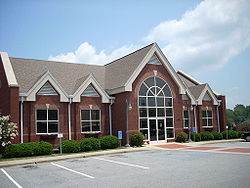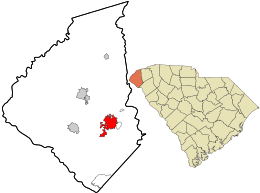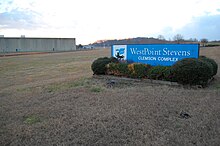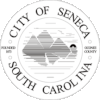Seneca, South Carolina
Seneca, South Carolina | |
|---|---|
 Seneca City Hall | |
| Motto(s): "City of Smiles, City with Style" | |
 Location inOconee Countyand the state ofSouth Carolina. | |
| Coordinates:34°41′3″N82°57′21″W/ 34.68417°N 82.95583°W | |
| Country | United States |
| State | South Carolina |
| County | Oconee |
| Government | |
| • Mayor | Daniel W. Alexander |
| Area | |
| • Total | 8.30 sq mi (21.49 km2) |
| • Land | 8.24 sq mi (21.35 km2) |
| • Water | 0.05 sq mi (0.14 km2) |
| Elevation | 951 ft (290 m) |
| Population | |
| • Total | 8,850 |
| • Density | 1,073.64/sq mi (414.55/km2) |
| Time zone | UTC−5(Eastern (EST)) |
| • Summer (DST) | UTC−4(EDT) |
| ZIP codes | 29672, 29678, 29679 |
| Area code | 864 |
| FIPS code | 45-65095[4] |
| GNISfeature ID | 1250833[2] |
| Website | www |
Senecais a city inOconee County,South Carolina,United States. The population was 8,102 at the2010 census.It is the principal city of the SenecaMicropolitan Statistical Area(population 74,273 at the2010 census), an (MSA) that includes all of Oconee County, and that is included within the greaterGreenville-Spartanburg-Anderson,South CarolinaCombined Statistical Area(population 1,266,995 at the2010 census). Seneca was named for the nearbyCherokeetown ofIsunigu,which English colonists knew as "Seneca Town".
History[edit]

In the antebellum period, this area was part of thePickens District, South Carolina.The state had used jurisdictions such as parish, county, district, and county again in its history. Oconee County was not organized until 1868, after the American Civil War.
Seneca was founded in 1873, during theReconstruction era,as the railroad town "Seneca City", named for theSeneca Riverand a historicCherokeetown known asIsunigu.It was called Seneca in a kind of transliteration by British colonists.
Seneca City was developed at the intersection of theBlue Ridge Railroadand the newly built Atlanta and Charlotte Air Line Railroad. Both lines are now part of theNorfolk Southern Railway.A. W. Thompson and J. J. Norton, who werelocating engineersfor the Air Line Railroad, purchased the land from Col. Brown ofAnderson, South Carolina,also in the large Pickens District. A stake marking the center of town was driven into the ground at the intersection of the railroad tracks and the current Townville Street. The land was divided into lots for a one-half mile from the stake. An auction was held on August 14, 1873. The town was given a charter by thestate legislatureon March 14, 1874. In 1908, the name was changed to the shorter Seneca.

Seneca developed as a marketing and shipping point for cotton, the major commodity crop in this uplands area. During the harvest, wagons bringing cotton would line up for blocks from the railroad station. A passenger terminal, several hotels, and a park were built near the railroad tracks. Recently, this park was named the Norton-Thompson Park in honor of the city's founders.
The first school was built in 1874. The community also was home of theSeneca Institute - Seneca Junior College,established here in 1899 as anhistorically black college.It was reserved for African-American students until 1939.

Textile mills were built in the area; a plant-and-mill village was built in 1893 by the Courtenay Manufacturing Company inNewryon theLittle River,which supplied hydropower for the mill. W.L. Jordon built another textile plant and mill village east of Seneca. This village has been called Jordania, Londsdale, andUtica;these changes accompanied changes in ownership of the plant. TheJ. P. StevensPlant, which was later called the Westpoint Stevens Plant, was a largetextile millbuilt onLake Hartwell.Its workforce was integrated, unlike most other plants that hired only whites. Many other textile mills were developed in this area. These plants were the main industry for Seneca for the first half of the twentieth century. With the shift of these jobs overseas, these textile mills are now closed.
In the late 20th century, major dam projects were constructed n the Keowee and other local rivers, to support recreation and public utilities. These projects created three major lakes:Lake Hartwellin 1963,Lake Keoweein 1971, andLake Jocasseein 1974, stimulating development in Seneca and the region. Duke Power'sOconee Nuclear Stationwas built on Lake Keowee, drawing cooling water for its operations from the lake.
The recreation provided by the lakes, and other attractions, such as nearbyClemson Universityattracted many retirees from other parts of the country. Retirement communities have been built in the area.[5]Concerned about over-development, some residents formed the Friends of Lake Keowee Society (FOLKS) to advocate for balance.[6]
Early on April 13, 2020, ahigh-end EF3 tornadostruck residential areas south and east of Seneca. Many buildings were damaged or destroyed and one person was killed.[7]
National Register of Historic Places listings[edit]
In and around Seneca, there are a number of historic buildings and districts that are on theNational Register of Historic Places:[8]
- Seneca Historic Districtwas listed in 1974. It is located south of the railroad tracks. The district consists of several homes and three churches that were built in the late nineteenth and early twentieth centuries. The houses have architectural styles that were popular in the period. It also includes a log cabin from the mid-nineteenth century that was moved from Long Creek, South Carolina. The South Carolina Department of Archives and History has additional pictures and information,[9]copies of the nomination forms,[10][11]and a map of the district.[12]
- Ram Cat Alley Historic Districtwas listed in 2000. It is a twenty-one-building commercial district built in the 1880s to the 1930s. The name of the street came from cats that gathered around a meat market. Many of these buildings have been rejuvenated and now house restaurants, shops, and professional offices. The South Carolina Department of Archives and History has additional pictures and information,[13]a copy of the nomination form,[14]and a map.[15]
- Newry Historic Districtwas listed in 1982. It is a historictextile millvillage near Seneca. The South Carolina Department of Archives and History has additional pictures and information,[16]a copy of the nomination form,[17]and a map.[18]
- Alexander-Hill House
- Faith Cabin Library at Seneca Junior College
- McPhail Angus Farm
- Old Pickens Presbyterian Church
Geography[edit]
Seneca is located at34°41′3″N82°57′21″W/ 34.68417°N 82.95583°W(34.684145, -82.955778).[19]
According to theUnited States Census Bureau,the city has a total area of 7.1 square miles (18 km2), of which 7.1 square miles (18 km2) is land and 0.04 square miles (0.10 km2) (0.56%) is water.
Demographics[edit]
| Census | Pop. | Note | %± |
|---|---|---|---|
| 1880 | 382 | — | |
| 1900 | 920 | — | |
| 1910 | 1,313 | 42.7% | |
| 1920 | 1,460 | 11.2% | |
| 1930 | 1,929 | 32.1% | |
| 1940 | 2,155 | 11.7% | |
| 1950 | 3,649 | 69.3% | |
| 1960 | 5,227 | 43.2% | |
| 1970 | 6,027 | 15.3% | |
| 1980 | 7,436 | 23.4% | |
| 1990 | 7,726 | 3.9% | |
| 2000 | 7,652 | −1.0% | |
| 2010 | 8,102 | 5.9% | |
| 2020 | 8,850 | 9.2% | |
| U.S. Decennial Census[20] 2020[3] | |||
2020 census[edit]
| Race | Num. | Perc. |
|---|---|---|
| White(non-Hispanic) | 5,556 | 62.78% |
| Black or African American(non-Hispanic) | 2,143 | 24.21% |
| Native American | 25 | 0.28% |
| Asian | 108 | 1.22% |
| Pacific Islander | 3 | 0.03% |
| Other/Mixed | 484 | 5.47% |
| HispanicorLatino | 531 | 6.0% |
As of the2020 United States census,there were 8,850 people, 4,043 households, and 2,138 families residing in the city.
2000 census[edit]
As of thecensus[4]of 2000, there were 7,652 people, 3,286 households, and 2,096 families residing in the city. The population density was 1,084.6 inhabitants per square mile (418.8/km2). There were 3,677 housing units at an average density of 521.2 per square mile (201.2/km2). The racial makeup of the city was 63.32%White,33.77%African American,0.31%Native American,0.63%Asian,0.01%Pacific Islander,0.65% fromother races,and 1.31% from two or more races.HispanicorLatinoof any race were 1.53% of the population.
There were 3,286 households, out of which 27.4% had children under the age of 18 living with them, 42.2% weremarried couplesliving together, 17.5% had a female householder with no husband present, and 36.2% were non-families. Of all households 32.3% were made up of individuals, and 13.2% had someone living alone who was 65 years of age or older. The average household size was 2.32 and the average family size was 2.93.
In the city, the population was spread out, with 24.4% under the age of 18, 9.5% from 18 to 24, 25.3% from 25 to 44, 24.7% from 45 to 64, and 16.0% who were 65 years of age or older. The median age was 38 years. For every 100 females, there were 87.5 males. For every 100 females age 18 and over, there were 83.0 males.
The median income for a household in the city was $32,643, and the median income for a family was $44,487. Males had a median income of $31,381 versus $21,472 for females. Theper capita incomefor the city was $18,498. About 13.0% of families and 15.6% of the population were below thepoverty line,including 23.0% of those under age 18 and 16.4% of those age 65 or over.
Government[edit]
Seneca City Hall is located on North First Street, in the center of the historic (downtown) area of Seneca. North First Street is also marked as Highway 123 Business. The City Hall Complex holds the Seneca Police Dept, Seneca Light and Water, as well as the offices of the Mayor and City Administrator.
Seneca Fire Department is housed on West South Fourth Street, in a new complex. The Fire House is just across the street from the Shaver Complex, which comprises the Shaver Civic Center, sports fields for the Seneca Recreation Department, a park for smaller children, and a rubberized soft walking track.
Education[edit]
Seneca has alending library,a branch of the Oconee County Public Library.[22]
Until June 2020, it was the headquarters of theNational Council of Examiners for Engineering and Surveying(NCEES), the council that deals with the examination forengineersandsurveyors.On that date, the NCEES moved toGreenville, South Carolina.
Notable people[edit]
- Willie Aikens,Major League Baseball player
- Bennie Cunningham,National Football League player
- John Edwards,formerU.S. Senator from North Carolina(1999–2005), and2004Democratic nominee forVice PresidentunderJohn Kerry;candidate for president in2008
- Lindsey Graham,U.S. Senator from South Carolinasince 2003[23]
- Clarence Kay,National Football League player
- Jimmy Orr,retired All-Pro National Football League player
- Marshall Parker,politician
- Marv Rackley,Major League Baseball player
- Needtobreathe,Christian rockband
See also[edit]
References[edit]
- ^"ArcGIS REST Services Directory".United States Census Bureau.RetrievedOctober 15,2022.
- ^abU.S. Geological Survey Geographic Names Information System: Seneca, South Carolina
- ^ab"Census Population API".United States Census Bureau.RetrievedOctober 15,2022.
- ^ab"U.S. Census website".United States Census Bureau.RetrievedJanuary 31,2008.
- ^Louise Matheson Bell,Seneca: Visions of Yesterday,2003,ISBN0-9763843-0-2.
- ^Edgar, Walter, ed.The South Carolina Encyclopedia,University of South Carolina Press, 2006, p. 859,ISBN1-57003-598-9.
- ^National Weather Service Weather Forecast Office in Greenville-Spartanburg, South Carolina (April 13, 2020).NWS Damage Survey for EF3 Tornado Event(Report). Iowa Environmental Mesonet.RetrievedApril 13,2020.
- ^"National Register Information System".National Register of Historic Places.National Park Service.July 9, 2010.
- ^Pictures of the Seneca Historic District
- ^Seneca Historic District nomination form I
- ^Seneca Historic District nomination form II
- ^Map of Seneca Historic District
- ^Pictures of the Ram Cat Alley Historic District
- ^Ram Cat Alley Historic District nomination form
- ^Map of the Ram Cat Alley Historic District
- ^Pictures of the Newry Historic District
- ^Newry Historic District nomination form
- ^Map of the Newry Historic District
- ^"US Gazetteer files: 2010, 2000, and 1990".United States Census Bureau.February 12, 2011.RetrievedApril 23,2011.
- ^"U.S. Decennial Census".United States Census Bureau.RetrievedJanuary 18,2015.
- ^"Explore Census Data".data.census.gov.RetrievedDecember 14,2021.
- ^"South Carolina libraries and archives".SCIWAY.RetrievedJune 13,2019.
- ^"United States Senator Lindsey Graham, South Carolina: Biography".Lgraham.senate.gov.RetrievedMay 8,2016.



